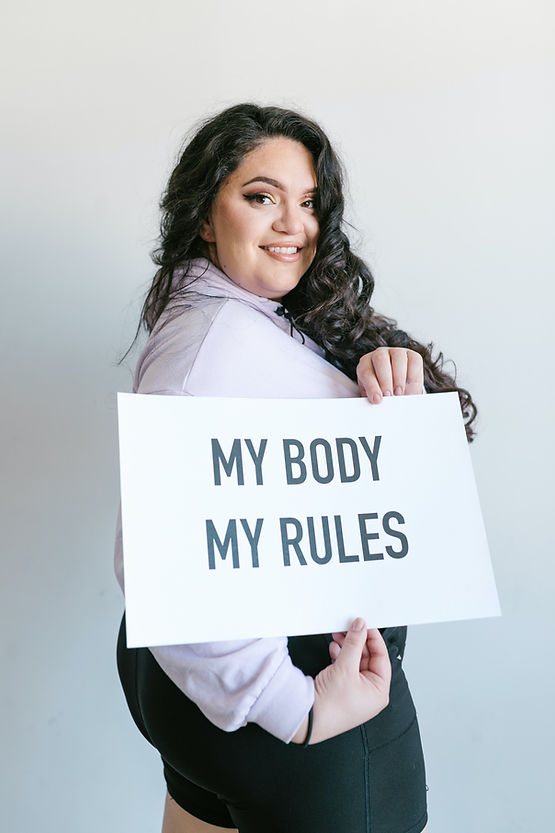Embodiment & Emotional Intelligence: How to Overcome Body Shame

Body shame: an internal sense of shame about one’s body size, shape, or appearance.
Snuggling into the beanbag, I tilted my head back, eyes locked on the boy I was crushing on. He sat on the edge of my dorm bed, explaining why he chose engineering. I shared my dream of becoming a singer—on Broadway or in Nashville. I didn’t know which, only that singing made me feel whole, complete, and embodied.
Then, after my first year, everything changed. College hit me like a tidal wave—new responsibilities, uncertainty, and fear. Suddenly, my dream felt reckless. I needed something stable.
“I’m majoring in exercise physiology!” I announced.
He turned to me and said, “Aren’t exercise physiologists supposed to be thinner?”
The Seeds of Body Shame
I was already struggling. Part of me was excited about college, but another part felt terrified to leave behind my mom, sister, high school, choir practices, and the comfort of routine. My world no longer felt familiar or safe.
I started as a Vocal Performance major, but in my search for security, I switched to exercise physiology. Looking back, I see why. I had stopped trusting my feelings. I relied on others to tell me what was best. And in that moment, when the guy I liked questioned my body, I started questioning it too.
If I could relive that moment, I’d laugh in his face and call out his ignorance. I wish I’d had that confidence. Instead, his comment planted the seeds of body shame, self-doubt, and an eventual eating disorder.
I disconnected from my body. It was no longer a home that needed care and protection. It wasn’t the vessel that carried my voice, allowing me to share my songs with the world. Instead, my body became an object to control, punish, and blame for my fears. It bore the scars of a dysregulated nervous system.
The Systemic Forces Behind Body Shame
At that time, I was not aware of the many systemic forces already at work, dismantling the trust between me and my body be them social, political, cultural, or generational. As I began exploring my experience more fully, however, I came to understand the myriad ways in which we are taught to view our bodies mechanistically, as something to be controlled.
As we proceed, I’ll share four important research-backed capacities that have served as pillars of my embodiment foundation. I’ve developed practices from these concepts that have helped heal body shame and the relationships I have with food, emotions, and myself. Their impact on my sense of resilience and capacity has been remarkable. They have also been integral in the healing paths of my clients.
In this blog, we will focus on the first of these four, emotional intelligence. I will share what my personal and professional experiences have shown me over the years and offer insights as to how you can begin (or continue) your process of healing body shame and your unhealthy relationship with food, whatever that looks like.
The 4 key areas of practice include the following:
1. Emotional Intelligence
2. Self-Regulation
3. Self-Compassion
4. Positive Neuroplasticity

Emotional Intelligence: A Path to Embodiment
Many definitions exist for emotional intelligence, but for me and my work with clients, it’s best defined simply as the ability to recognize and manage within ourselves and others, the emotions that we are experiencing.
The definition is simple, however, in practice, it’s not easy. Many of us grew up in environments where emotion was not tolerated, much less welcome or expressed in safe, nurturing ways. Instead of learning how to recognize and honor emotions, we learned how to suppress, avoid, distrust, fear, or resist emotions.
For many, emotions were threatening to feel. We learned that if we felt a certain way, we were bad– that negative consequences were possible if we showed specific emotions. So not only did we learn to move away from emotions, we simultaneously learned to hide important parts of ourselves to please others, appease those who took care of us, or not rock the boat within our family dynamic because it was legitimately physically or psychologically dangerous to do so.
It’s an important part of recovery and healing to begin approaching emotion differently, and to do so, we must learn about how our bodies show us that they are experiencing emotion. For those of us who struggle with disordered eating and body image dysfunction, or who have sordid histories with dieting, we will often move toward controlling food or exercise when we are feeling out of control or experiencing unpleasant emotions. We can use these compensatory behaviors as a cue that we may be suppressing emotion.
How to Rebuild Emotional Intelligence & Overcome Body Shame
I often ask my clients, “How do you know you’re experiencing [emotion]?”
Each emotion has a felt sense in the body. Anxiety might feel like a tight chest. Sadness might feel like heaviness in the limbs. Joy might feel like warmth spreading outward.
Naming these sensations is crucial. When we shift from judging emotions to sensing them, we move toward embodiment.
Instead of labeling emotions as “bad” or “good,” we practice noticing what’s happening inside. Over time, this practice helps us feel safe in our bodies again.
I like to describe emotion as energy in motion. We can literally sense, in our bodies, a shift, that tells us energy is present. It might be an expansion, tension or tightening, constriction, heaviness, an increase or decrease in temperature, aching, hollowness, or buzziness. The words we use to describe the sensory experience of an emotion are vast, but learning how to sense that shift in energy is where our intelligence blossoms and the relationship we have with ourselves grows.
We learn that we don’t have to like the “felt sense,” but we also learn what the consequences are of pushing it away, ignoring it, acting as if it doesn’t exist, and suppressing it.
Emotions Demand to Be Felt
You’ve likely heard the phrase, “emotions will demand to be felt.” Imagine an emotion as a person. If you shove them away, they might fight back. If you ignore a child pulling on your sleeve, they’ll scream louder. Suppressed emotions work the same way.
For many, unprocessed emotions show up as:
- Overworking or avoiding responsibility
- Disordered eating behaviors
- Body image struggles
- Perfectionism
Emotions are Dismissed by Our Culture
For body image dysfunction and disordered eating specifically, learning to take the stairs from the mind’s assessment, evaluation, criticism, judgment, and critique is a vital skill. Many of us have been conditioned to ignore our internal needs, including our appetites, feelings, pleasure, and desires. Instead, we focus on our appearance and external shape, size, and look. We aim for our bodies to provide pleasure for others, and we seek approval and acceptance through our appearance.
With so many of the women I work with, when asked about their body image, they will share, “No, I don’t like the way I look.” And they’ll list the myriad ways in which they’ve tried to change their bodies, each way requiring a minimization or complete dismissal of how they feel physiologically, emotionally, mentally, energetically, spiritually, relationally, and environmentally! At what point did our appearance become more important than our autonomy? When did a focus on how we look supersede a focus on love? How did weight become tied to our worth?
Healing body shame requires turning toward our emotions rather than using our bodies as scapegoats.

Learning to take the stairs and feel what we’re feeling means we can develop a different relationship with our bodies and ourselves—relationships that are compassionate, gentle, tender, fierce, accepting, respectful, friendly, empathic, honest, genuine, trusting, open, creative, rooted, and pleasing.
Emotional intelligence invites us to be with our bodies, as is so refreshingly described by Lindsay Kite, body image researcher and founder of Body Redefined, as instruments versus ornaments. Feeling our feelings also conveys the message to our bodies that they are safe and reinforces that wellbeing and worth is most soundly developed from the inside-out, not the outside-in.
One of my clients is a very visual person. She understands and integrates things in images and color and shapes. When we began working toward her personal practice of taking the stairs from her mind into her body, she knew it would be important to have reminders or cues to trigger the behavior. She lives in her mind, as so many of us do, and she is coming to understand just how often she’ll become hijacked by certain thoughts and stories that run away with her attention. Often the stories are full of worst-case scenarios, assumptions, and critiques that draw her into herself. She notices how they will cause her to isolate, and as she describes it, she feels the vitality drain from her body. All motivation goes out the window.
name what you feel, not just what you think
She found vivid pictures of stairs and posted them in her apartment. On her phone, she set her lock screen and home screens with stair images as well. The stairs are an all-the-time signal to first, take a long diaphragmatic breath in, and an even longer exhale. The breath moves her into her body because her attention goes into the feeling of breathing—the expansion of her stomach and chest as she inhales and the release as she exhales. The longer exhale serves as a cue to her nervous system that she is safe, which triggers a relaxation of her muscles, and she is moved into a calmer, less buzzy, mental space. A large part of our work is about becoming educated in the ways of her nervous system and the stress response.
As she breathes, her attention is moved into the interior of her body, and it’s in that space where she can practice developing what’s called interoceptive awareness. She’s learning to ask, “What’s here?”
Her mind may call it “anxiety” or “frustration” or “sadness,” while her body speaks in sensations.
Until the mind weaves a story about the sensation, a sensation is neutral. Tender, for example, is just tender, until the mind creates a narrative that tender is “bad” or “dangerous.”
Empty is just empty, until the mind creates a narrative that empty is “scary” or “lonely” or whatever else she becomes aware of is associated with specific feelings in her body.
But that’s the point! She’s developing a deeper awareness and intelligence around the feelings themselves and noticing if there’s a judgement attached to them.
The noticing itself is an important step because it creates a pause that opens up a space through which she can respond differently. As Victor Frankl shared, “Between the stimulus and response is a space, and in that space is your freedom to choose.”
She might ask what that feeling needs from her. She can imagine the feeling as a small child needing love, care, and warmth, and if she turns toward it, it will shift on its own, opening to more space and greater ease.
Take the Stairs: Moving from Head to Body
Many of us live in our heads, trapped in overthinking, self-criticism, and worst-case scenarios. The key is to take the stairs down into the body—to feel rather than analyze.
Try this:
Ask, “What else is here?” Often when we are caught in a stress response, it can feel like we’re driving around in circles. I recall a time when I was in Barbados, where the cars have the steering wheel on the right side, and I was caught in a traffic circle, confused and disoriented, and literally going in circles! Sometimes the mind gets stuck in the same way. We ruminate on the same thing repeatedly, often in an effort to figure something out or problem-solve. But it’s not effective.
The 3 P’s Trap & Body Shame
As psychologist, Martin Seligman has described, people tend to move in three specific directions, what he calls the “3 P’s,” sometimes all of them at once, when experiencing setbacks.
The “what else is here?” question can help us to avoid going down the road of pervasiveness. When pervasiveness takes hold, we believe that everything is all bad or all wrong. When one thing doesn’t go as we hoped or expected, or something feels particularly difficult, we can fall into the pervasiveness trap of “everything is difficult!”
The exit from pervasiveness can be recognizing what else is here. It might be the appreciation we feel for a friend’s concern and support, the warmth of the blanket on our skin, the feeling of my fingers on the keyboard, the project I am enjoying working on, or the dinner I’m looking forward to with my partner that evening.
We may also fall into the trap of “what ifs,” and the exit can be aligning with “what is.”
This redirects our attention to the present. What is true, absolutely true, that I can ground myself around right now as a resource? This is an intellectual and cognitive practice, but you can make it a body based one as well. When you recognize the spinning in your mind, let it be a cue for caring for yourself.
Redirect attention with sensory awareness
When caught in body shame or rumination, use your senses to anchor in the present.
Move into a sensory exercise that has you directing your attention to all the senses. See if you can do it without any judgment at all!
- What do I see right now? Describe the colors, the shapes, the situation.
- What do I hear right now? Describe the sounds around you, differentiating each one.
- What do I taste right now? Certainly, you could do this while you’re eating, picking out each flavor in the bite of food, but you could also just notice the taste that’s present in your mouth.
- What do I feel right now? If you’re in a chair, can you notice the weight of your body in the seat, the feeling of your back being supported? Can you feel your feet on the floor or inside your shoes? The sun touching your skin?
- What do I smell right now? Just observe what scents tickle your nose.
This practice moves you to direct your attention and focus into your body. It also invites you practice redirecting your attention entirely.
Dr. Dan Siegel describes a practice he calls the Wheel of Awareness, where he asks you to just put your attention in the hub of a wheel. In the hub is just awareness of your awareness. It’s just observing that we can observe! It’s a knowing that we know things. Then, you can move your attention from the hub to a spoke on the wheel. One spoke is seeing, one his hearing, one is touching, and so on.
exiting the dead-end road of mental rumination
What we’re doing is exiting from the dead-end road of rumination, and it’s emotional intelligence that allows us to notice when we’re on that road in the first place! For those of us healing from disordered eating or body image dysfunction, we can get stuck in the negative thoughts about our bodies, the obsessions about weighing and tracking of food or counting calories, and the harmful ideas perpetuated by diet culture. We can practice feeling what happens in our bodies when we believe the thoughts, and we can practice acknowledging that the thoughts are there, but not let them direct our behavior. Instead, we can redirect and align with our other important values and ask, “what else is here?”
Emotional Intelligence invites us into a relationship with ourselves that is much more nuanced, accepting, respectful, and authentic. When we’re struggling with body image dysfunction and disordered eating, our bodies become the target of our difficult or uncomfortable emotions vs a vessel through which they can be wisely and compassionately understood, experienced, and expressed.
Healing from Body Shame Is a Reclamation Process
Healing means unlearning the messages that taught us to view our bodies as problems. It means reclaiming our right to feel, express, and inhabit our bodies fully.
When my clients tell me that they feel so fat, or uncomfortable, or heavy, we will often look for what else in their lives feels fat, uncomfortable, or heavy. Is there something happening in your life right now that feels heavy to be with or overwhelming?
It very well may be that their bodies are feeling uncomfortable in some way, and then the work is to care for and preserve their integrity vs jumping into controlling behaviors with food or exercise. In situations like this, if we don’t have the skills to be with the emotions that are present, we will absolutely turn to something to help ourselves feel better. No matter what it is, if you are healing, it’s important that you view what you turn to not as self-sabotage, but as self-preservation.
Incorporating practices that grow our emotional intelligence is a reclamation process. By unlearning much of what we came to understand was appropriate, regarding emotions, expression of them, our bodies and their appetites, desires, and hungers, we open a space for relearning and reclaiming our bodies as our homes and our teachers.

Reflections: Your Body Has a Story to Tell
Please take some time to reflect on your personal journey, and please take care while doing so. Everyone has a story about their bodies. And if we asked our bodies, they would have a story they’d like to tell too.
- What did you learn about emotions growing up?
- What emotions were acceptable/unacceptable?
- What did you learn about bodies?
- What did you learn about your body?
- When do you remember first believing that your body was a problem?
- What did you see or hear around you regarding bodies?
- What emotions, now, do you try to get away from, hide, avoid, or feel yourself fighting against?
- What underlying beliefs or ideas play a role in your relationship with your body and food?
- How would your life change if you began to trust that your body has your back?
- If the relationship you have with your emotions shifted even just a bit toward greater appreciation or respect, what do you imagine would be different in your life?
- What are the barriers to or what has come between you and feeling at home in your body?
In the next installment of this four-part series, we’ll discuss the capacity of self-regulation for embodiment and healing.






